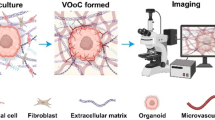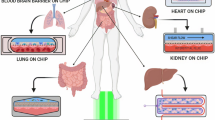Abstract
Life science research focuses on deciphering the biochemical mechanisms that regulate cell proliferation and function and largely depends on the use of tissue culture methods in which cells are grown on two-dimensional hard plastic or glass surfaces. However, the flat surface of the tissue culture plate represents a poor topological approximation of the complex three-dimensional (3D) architecture of a tissue or organ composed of various cell types, extracellular matrix (ECM) and interstitial fluids. Moreover, if we consider a cell as a perfectly defined volume, flattened cells have full access to the environment and limited cell-to-cell contact. However if the cell is a cube in a simple cuboidal epithelium, then its access to the lumen is limited to one face, with the opposite face facing the basal membrane and the remaining four faces lying in close contact with neighbouring cells. This is of great importance when considering the access of viruses and bacteria to the cell surface, the excretion of soluble factors or proteins or the signalling within or between cells. This short review discusses various cell culture approaches to improve the simulation of the 3D environment of cells.

Similar content being viewed by others
References
Bancroft GN, Sikavitsas VI, Dolder J van den, Sheffield TL, Ambrose CG, Jansen JA, Mikos AG (2002) Fluid flow increases mineralized matrix deposition in 3D perfusion culture of marrow stromal osteoblasts in a dose-dependent manner. Proc Natl Acad Sci USA 99:12600–12605
Barboni B, Curini V, Russo V, Mauro A, Di Giacinto O, Marchisio M, Alfonsi M, Mattioli M (2012) Indirect co-culture with tendons or tenocytes can program amniotic epithelial cells towards stepwise tenogenic differentiation. PLoS One 7:e30974
Battista S (2005) The effect of matrix composition of 3D constructs on embryonic stem cell differentiation. Biomaterials 26:6194–6207
Bierkvig R, Tonnesen A, Laerum OD, Backlund EO (1990) Multicellular tumor spheroids from human gliomas maintained in organ culture. J Neurosurg 72:463–475
Bierwolf J, Lutgehetmann M, Feng K, Erbes J, Deichmann S, Toronyi E, Stieglitz C, Nashan B, Ma PX, Pollock JM (2011) Primary rat hepatocyte culture on 3D nanofibrous polymer scaffolds for toxicology and pharmaceutical research. Biotechnol Bioeng 108:141–150
Birgersdotter A, Baumforth KRN, Porwit A, Sunblad A, Falk KI, Wei W, Sjöberg J, Murray PG, Björkholm M, Ernberg I (2007) Three-dimensional culturing of the Hodgkin lymphoma cell-line L1236 induces a HL tissue-like gene expression pattern. Leuk Lymphoma 48:2042–2053
Bolz J, Novak N, Staiger V (1992) Formation of specific afferent connections in organotypic slice cultures from rat visual cortex cocultured with lateral geniculate nucleus. J Neurosci 12:3054–3070
Buga GM, Griscavage JM, Rogers NE, Ignarro LJ (1993) Negative feedback regulation of endothelial cell function by nitric oxide. Circ Res 73:808–812
Cereijido M, Robbins ES, Dolan WJ, Rotunno CA, Sabantini CA (1978) Polarized monolayers formed by epithelial-cells on a permeable and translucent support. J Cell Biol 77:853–880
Choe MM, Tomei AA, Swartz MA (2006) Physiological 3D tissue model of the airway wall and mucosa. Nat Protoc 1:357–362
Clark J, Hirstenstein H, Gebb C (1980)Critical parameters in the microcarrier culture of animal cells. Dev Biol Stand 46:117–124
Cukierman E, Pankov R, Stevens DR, Yamada KM (2001) Taking cell-matrix adhesions to the third dimension.Science 294:1708-1712
Frondoza C, Sohrabi A, Hungerford D (1996) Human chondrocytes proliferate and produce matrix components in microcarrier suspension culture. Biomaterials 17:879–888
Glinsky VV, Huflejt ME, Glinsky GV, Deutscher SL, Quinn TP (2000) Effects of Thomsen-Friedenreich antigen-specific peptide P-30 on beta-galactoside-mediated homotypic aggregation and adhesion to the endothelium of MDA-MB-435 human breast carcinoma cells. Cancer Res 60:2584–2588
Grabowska I, Szeliga A, Moraczewski J, Czaplicka I, Brzoska E (2011) Comparison of satellite cell-derived myoblasts and C2C12 differentiation in two- and three-dimensional cultures: changes in adhesion protein expression. Cell Biol Int 35:125–133
Griffith LG, Swartz MA (2006) Capturing complex 3D tissue physiology in vitro. Nat Rev Mol Cell Biol 7:211–224
Hamilton GA, Jolley SL, Gilbert D, Coon DJ, Barros S, LeCluyse EL (2001) Regulation of cell morphology and cytochrome P450 expression in human hepatocytes by extracellular matrix and cell-cell interactions.Cell Tissue Res 306:85–99
Hammond TG, Hammond JM (2001)Optimized suspension culture: the rotating-wall vessel.Am J Physiol Renal Physiol 281:F12-F25
Hogan C, Kajita M, Lawrenson K, Fujita Y (2011) Interactions between normal and transformed epithelial cells: their contributions to tumourigenesis. Int J Biochem Cell Biol 43:496–503
Holopainen IE (2005) Organotypic hippocampal slice cultures: a model system to study basic cellular and molecular mechanisms of neuronal cell death, neuroprotection, and synaptic plasticity. Neurochem Res 30:1521–1528
Holtorf HL, Sheffield TL, Ambrose CG, Jansen JA, Mikos A (2005) Flow perfusion culture of marrow stromal cells seeded on porous biphasic calcium phosphate ceramics. Ann Biomed Eng 33:1238–1248
Hubbell JA (2003) Materials as morphogenetic guides in tissue engineering. Curr Opin Biotechnol 14:551–558
Hutmacher DW (2000) Scaffold design and fabrication technologies for engineering tissues—state of the art and future perspectives. J Biomater Sci Polym Ed 12:107–124
Hutmacher DW, Loessner D, Rizzi S, Kaplan DL, Mooney DJ, Clements JA (2009) Can tissue engineering concepts advance tumor biology research? Trends Biotechnol 28:125–133
Hyman AH, Simons K (2011) The new cell biology: beyond HeLa cells. Nature 480:34
Jamora C, Fuchs E (2002) Intercellular adhesion, signalling, and the cytoskeleton. Nat Cell Biol 4:E101–E108
Johns RA, Tichotsky A, Muro M, Spaeth JP, Le Cras TD, Rengasamy A (1995)Halothane and isoflurane inhibit endothelium-derived relaxing factor-dependent cyclic guanosine monophosphate accumulation in endothelial cell-vascular smooth muscle co-cultures independent of an effect on guanylyl cyclase activation.Anesthesiology 83:823–834
Kamp J van de, Kramann R, Anraths J, Schöler HR, Ko K, Knüchel R, Zenke M, Neuss S, Schneider RK (2012) Epithelial morphogenesis of germline-derived pluripotent stem cells on organotypic skin equivalents in vitro. Differentiation 83:138–147
Kawano MM, Huang N, Tanaka H, Ishikawa H, Sakai A, Tanabe O, Nobuyoshi M, Kuramoto A (1991) Homotypic cell aggregations of human myeloma with ICAM-1 and LFA-1 molecules. Br J Haematol 79:583–588
Keller JM (1995) In vitro differentiation of embryonic stem cells. Curr Opin Cell Biol 7:862–869
Kelm JM, Timmins NE, Brown CJ, Fussenegger M, Nielsen LK (2002) Method for generation of homogeneous multicellular tumor spheroids applicable to a wide variety of cell types. Biotechnol Bioeng 83:173–180
Kim BS, Nikolovski J, Bonadio J, Smiley E, Mooney DJ (1999) Engineered smooth muscle tissues: regulating cell phenotype with the scaffold. Exp Cell Res 251:318–328
Kim JB (2005) Three-dimensional tissue culture models in cancer biology. Semin Cancer Biol 15:365–377
Kunz-Schughart LA, Freyer JP, Hofstaedter F, Ebner R (2004) The use of 3-D cultures for high-throughput screening: the multicellular spheroid model. J Biomol Screen 9:273–285
Levenberg S, Huang NF, Lavik E, Rogers AB, Itskovitz-Eldor J, Langer R (2003) Differentiation of human embryonic stem cells on three-dimensional polymer scaffolds. Proc Natl Acad Sci USA 100:12741–12746
Levenberg S, Rouwkema J, Macdonald M, Garfein ES, Kohane DS, Darland DC, Marini R, Blitterswijk CA van, Mulligan RC, D’Amore PA, Langer R (2005) Engineering vascularized skeletal muscle tissue. Nat Biotechnol 23:879–884
Li L, Xie T (2005) Stem cell niche: structure and function. Annu Rev Cell Dev Biol 21:605–631
Li S, Lao J, Chen BP, Li YS, Zhao Y, Chu J, Chen KD, Tsou TC, Peck K, Chien S (2003) Genomic analysis of smooth muscle cells in 3-dimensional collagen matrix. FASEB J 17:97–99
Ma W, Fitzgerald W, Liu QY, O’Shaughnessy TJ, Maric D, Lin HJ, Alkon DL, Barker JL (2004) CNS stem and progenitor cell differentiation into functional neuronal circuits in three-dimensional collagen gels. Exp Neurol 190:276–288
Martin I, Wendt D, Heberer H (2004) The role of bioreactors in tissue engineering. Trends Biotechnol 22:80–86
Misfeldt DS, Hamamoto ST, Pitelka DR (1976) Transepithelial transport in cell culture. Proc Natl Acad Sci USA 73:1212–1216
Nakamura T, Kato Y, Fujii H, Horiuchi T, Chiba Y, Tanaka K (2003) E-cadherin-dependent intercellular adhesion enhances chemoresistance. Int J Mol Med 12:693–700
Nelson CM, Bissell MJ (2006) Of extracellular matrix, scaffolds, and signaling: tissue architecture regulates development, homeostasis, and cancer. Annu Rev Cell Dev Biol 22:287–309
O’Brien LE, Zegers MMP, Mostov KE (2002) Building epithelial architecture: insights from three-dimensional culture models. Nat Rev Mol Cell Biol 3:531–537
Pampaloni F, Reynaud EG, Stelzer EHK (2007) The third dimension bridges the gap between cell culture and live tissue. Nat Rev Mol Cell Biol 8:839–845
Pampaloni F, Stelzer EH, Masotti A (2009) Three-dimensional tissue models for drug discovery and toxicology.Recent Pat Biotechnol 3:103–117
Patterson BK, Landay A, Siegel JN, Flener Z, Pessis D, Chaviano A, Bailey RC (2002) Susceptibility to human immunodeficiency virus-1 infection of human foreskin and cervical tissue grown in explant culture. Am J Pathol 161:867–873
Pedersen JA, Swartz MA (2005) Mechanobiology in the third dimension. Ann Biomed Eng 33:1469–1490
Peretz H, Talpalar AE, Vago R, Baranes D (2007) Superior survival and durability of neurons and astrocytes on 3-dimensional aragonite biomatrices. Tissue Eng 13:461–472
Runswick SK, O’Hare MJ, Jones L, Streuli CH, Garrod DR (2001) Desmosomal adhesion regulates epithelial morphogenesis and cell positioning. Nat Cell Biol 3:823–830
Santini MT, Rainaldi G, Indovina PI (1998) Multicellular tumour spheroids in radiation biology. Int J Radiat Biol 75:787–799
Santini MT, Rainaldi G, Indovina PL (1999)Multicellular tumour spheroids in radiation biology. Int J Radiat Biol 75:787-799
Santini MT, Rainaldi G, Indovina PL (2000) Apoptosis, cell adhesion and the extracellular matrix in the three-dimensional growth of multicellular tumor spheroids. Crit Rev Oncol Hematol 36:75–87
Santos MI, Unger RE, Sousa RA, Reis RL, Kirkpatrick CJ (2009) Crosstalk between osteoblasts and endothelial cells co-cultured on a polycaprolactone–starch scaffold and the in vitro development of vascularization. Biomaterials 30:4407–4415
Storch K, Eke I, Borgmann K, Krause M, Richter C, Becker K, Schrock E, Cordes N (2010) Three-dimensional cell growth confers radioresistance by chromatin density modification. Cancer Res 10:3925–3934
Sutherland RM (1988) Cell and environment interactions in tumour microregions: the multicell spheroid model. Science 240:177–184
Tabata T, Takei Y (2004) Morphogens, their identification and regulation. Development 131:703–712
Tang Y, Wong C, Wang H, Sutti A, Kirkland M, Wang X, Lin T (2011) Three-dimensional tissue scaffolds from interbonded poly(ε-caprolactone) fibrous matrices with controlled porosity. Tissue Eng Part C Methods 17:209–218
Toda S, Watanabe K, Yokoi F, Matsumura S, Suzuki K, Ootani A, Aoki S, Koike N, Sugihara H (2002) A new organotypic culture of thyroid tissue maintains three-dimensional follicles with C cells for a long term. Biochem Biophys Res Commun 294:906–911
Vickerman V, Blundo J, Chung S, Kamm R (2008) Design, fabrication and implementation of a novel multi-parameter control microfluidic platform for three-dimensional cell culture and real-time imaging. Lab Chip 8:1468–1477
Watanabe Y, Costantini F (2004) Real-time analysis of ureteric bud branching morphogenesis in vitro. Dev Biol 271:98–108
Wezel AL van (1967)Growth of cell-strains and primary cells on micro-carriers in homogeneous culture. Nature 216:64-65
Yamada KM, Cukierman E (2007) Modelling tissue morphogenesis and cancer in 3D. Cell 130:601–610
Yuhas JM, Li AP, Martinez AO, Ladman AJ (1977) A simplified method for production and growth of multicellular tumor spheroids. Cancer Res 37:3639–3643
Zhang X, Xie Y, Koh CG, James Lee L (2009) A novel 3-D model for cell culture and tissue engineering. Biomed Microdevices 11:795–799
Author information
Authors and Affiliations
Corresponding author
Rights and permissions
About this article
Cite this article
Page, H., Flood, P. & Reynaud, E.G. Three-dimensional tissue cultures: current trends and beyond. Cell Tissue Res 352, 123–131 (2013). https://doi.org/10.1007/s00441-012-1441-5
Received:
Accepted:
Published:
Issue Date:
DOI: https://doi.org/10.1007/s00441-012-1441-5




